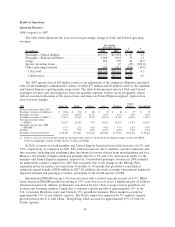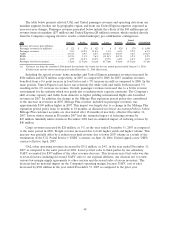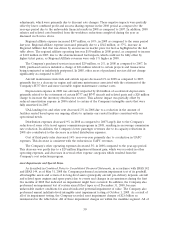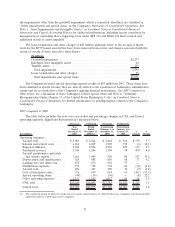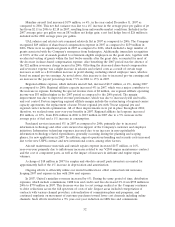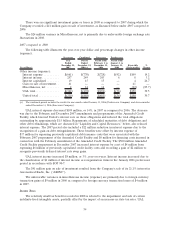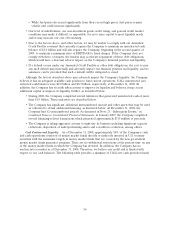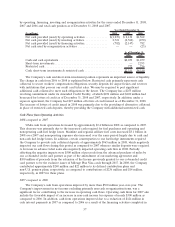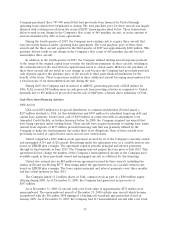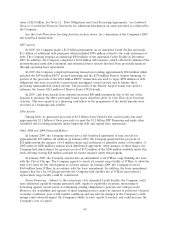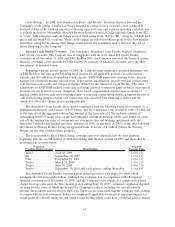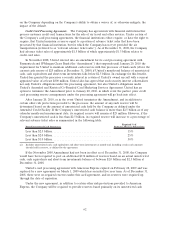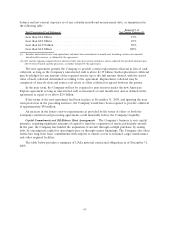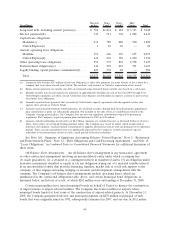United Airlines 2008 Annual Report Download - page 55
Download and view the complete annual report
Please find page 55 of the 2008 United Airlines annual report below. You can navigate through the pages in the report by either clicking on the pages listed below, or by using the keyword search tool below to find specific information within the annual report.recorded income tax expense of $297 million for the year ended December 31, 2007 based an estimated
effective tax rate of 43%. See Note 8, “Income Taxes,” in Combined Notes to Consolidated Financial
Statements for additional information.
Liquidity and Capital Resources
As of the date of this Form 10-K, the Company believes it has sufficient liquidity to fund its
operations for the next twelve months, including funding for scheduled repayments of debt and capital
lease obligations, capital expenditures, cash deposits required under fuel hedge contracts and other
contractual obligations. We expect to meet our liquidity needs in 2009 from cash flows from operations,
cash and cash equivalents on hand, proceeds from new financing arrangements using unencumbered
assets and proceeds from aircraft sales and sales of other assets, among other sources. While the
Company expects to meet its future cash requirements in 2009, our ability to do so could be impacted by
many factors including, but not limited to, the following:
• Volatile fuel prices and the cost and effectiveness of hedging fuel prices, as described above in
the Overview and Results of Operations sections, may require the use of significant liquidity in
future periods. Crude oil prices have been extremely volatile and unpredictable in recent years
and may become more volatile in future periods due to the current severe dislocations in world
financial markets.
• In late 2008, the price of crude oil dramatically fell from its record high in July 2008. Earlier in
2008, the Company entered into derivative contracts (including collar strategies) to hedge the risk
of future price increases. As fuel prices have fallen below the floor of the collars, the Company
has had, and could continue to have, significant future payment obligations at the settlement
dates of these contracts. In addition, the Company has been and may in the future be further
required to provide counterparties with additional cash collateral prior to such settlement dates.
While the Company’s results of operations should benefit significantly from lower fuel prices on
its unhedged fuel consumption, in the near term lower fuel prices could also significantly and
negatively impact liquidity based on the amount of cash settlements and collateral that may be
required. However, at December 31, 2008 the Company partially mitigated its exposure to further
price declines by purchasing put options to effectively cover approximately 55% of its short put
positions. In addition, over the longer term, lower crude oil prices will further benefit the
Company as the unfavorable hedge contracts terminate and the Company realizes the benefit of
lower jet fuel costs on a larger percentage of its fuel consumption. See Note 13, “Fair Value
Measurements and Derivative Instruments” in Combined Notes to Consolidated Financial
Statements, as well as Item 7A, Quantitative and Qualitative Disclosures Above Market Risk, for
further information regarding the Company’s fuel derivative instruments.
• The Company’s current operational plans to address the severe condition of the global economy
may not be successful in improving its results of operations and liquidity:
• The Company may not achieve expected increases in unit revenue from the capacity reductions
announced by the Company and certain of its competitors. Further, certain of the Company’s
competitors may not reduce capacity or may increase capacity; thereby diminishing our
expected benefit from capacity reductions. The Company may also not achieve expected
revenue improvements from merchandising and fee enhancement initiatives.
• Poor general economic conditions have had, and may in the future continue to have, a
significant adverse impact on travel demand, which may result in a negative impact to
revenues.
• The Company is using cash to implement its operational plans for such items as severance
payments, lease termination payments, conversion of Ted aircraft and facility closure costs,
among others. These cash requirements will reduce the Company’s cash available for its
ongoing operations and commitments.
55



